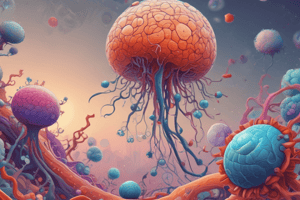Podcast
Questions and Answers
The Golgi apparatus is primarily responsible for generating energy for the cell through cellular respiration.
The Golgi apparatus is primarily responsible for generating energy for the cell through cellular respiration.
False (B)
Cells can only undergo mitosis if they have an odd number of chromosomes.
Cells can only undergo mitosis if they have an odd number of chromosomes.
False (B)
Lysosomes are involved in the synthesis of proteins.
Lysosomes are involved in the synthesis of proteins.
False (B)
Carrier proteins are used in passive transport to facilitate the movement of molecules across the cell membrane.
Carrier proteins are used in passive transport to facilitate the movement of molecules across the cell membrane.
The nucleus is primarily involved in the synthesis of proteins.
The nucleus is primarily involved in the synthesis of proteins.
Meiosis is the process of cell division resulting in two daughter cells with the same number of chromosomes as the parent cell.
Meiosis is the process of cell division resulting in two daughter cells with the same number of chromosomes as the parent cell.
The endoplasmic reticulum is involved in the modification and secretion of hormones.
The endoplasmic reticulum is involved in the modification and secretion of hormones.
Signal transduction pathways are involved in the transmission of genetic information from DNA to proteins.
Signal transduction pathways are involved in the transmission of genetic information from DNA to proteins.
Osmosis is a type of active transport that requires energy.
Osmosis is a type of active transport that requires energy.
Ribosomes are found in the nucleus of eukaryotic cells.
Ribosomes are found in the nucleus of eukaryotic cells.
Flashcards are hidden until you start studying
Study Notes
Cell Structure
- Plasma Membrane: Semi-permeable membrane that separates cell from environment, regulates what enters/leaves cell
- Cytoplasm: Jelly-like substance inside cell membrane, site of metabolic reactions
- Nucleus: Control center of cell, contains genetic material (DNA)
- Mitochondria: Powerhouses of cell, generate energy through cellular respiration
- Endoplasmic Reticulum (ER): Network of membranous tubules and sacs, involved in protein synthesis and transport
- Ribosomes: Small organelles found throughout cytoplasm, site of protein synthesis
- Lysosomes: Membrane-bound sacs containing digestive enzymes, break down and recycle cellular waste
- Golgi Apparatus: Complex of flattened sacs and tubules, involved in protein modification and secretion
Cell Transport
- Passive Transport: Movement of molecules from high to low concentration, no energy required
- Diffusion: Movement of molecules from high to low concentration until equilibrium
- Osmosis: Movement of water molecules through selectively permeable membrane
- Active Transport: Movement of molecules from low to high concentration, energy required
- Pump: Uses energy to move molecules against concentration gradient
- Carrier Proteins: Bind to molecules and transport them across membrane
Cell Division
- Mitosis: Process of cell division resulting in two daughter cells with same number of chromosomes as parent cell
- Interphase: Cell growth and preparation for cell division
- Prophase: Chromatin condenses, nuclear envelope breaks down
- Metaphase: Chromosomes line up at center of cell
- Anaphase: Sister chromatids separate
- Telophase: Nuclear envelope reforms, chromatin uncoils
- Meiosis: Process of cell division resulting in four daughter cells with half the number of chromosomes as parent cell
Cell Signaling
- Signal Transduction Pathways: Series of molecular events that transmit signal from receptor to response
- Receptors: Proteins that bind to signaling molecules (ligands)
- Signaling Molecules: Hormones, neurotransmitters, growth factors, etc.
- Response: Cellular response to signal, e.g. gene expression, protein activation
Cell Structure
- Plasma membrane is semi-permeable, regulating what enters and leaves the cell
- Cytoplasm is a jelly-like substance inside the cell membrane, site of metabolic reactions
- Nucleus is the control center of the cell, containing genetic material (DNA)
- Mitochondria are the powerhouses of the cell, generating energy through cellular respiration
- Endoplasmic Reticulum (ER) is a network of membranous tubules and sacs, involved in protein synthesis and transport
- Ribosomes are small organelles found throughout the cytoplasm, site of protein synthesis
- Lysosomes are membrane-bound sacs containing digestive enzymes, breaking down and recycling cellular waste
- Golgi Apparatus is a complex of flattened sacs and tubules, involved in protein modification and secretion
Cell Transport
- Passive transport involves the movement of molecules from high to low concentration, requiring no energy
- Diffusion is the movement of molecules from high to low concentration until equilibrium
- Osmosis is the movement of water molecules through a selectively permeable membrane
- Active transport involves the movement of molecules from low to high concentration, requiring energy
- Pumps use energy to move molecules against the concentration gradient
- Carrier proteins bind to molecules and transport them across the membrane
Cell Division
- Mitosis is the process of cell division resulting in two daughter cells with the same number of chromosomes as the parent cell
- Interphase involves cell growth and preparation for cell division
- Prophase involves chromatin condensing and the nuclear envelope breaking down
- Metaphase involves chromosomes lining up at the center of the cell
- Anaphase involves sister chromatids separating
- Telophase involves the nuclear envelope reforming and chromatin uncoiling
- Meiosis is the process of cell division resulting in four daughter cells with half the number of chromosomes as the parent cell
Cell Signaling
- Signal transduction pathways are a series of molecular events that transmit signals from receptors to responses
- Receptors are proteins that bind to signaling molecules (ligands)
- Signaling molecules include hormones, neurotransmitters, growth factors, etc.
- Response is the cellular response to the signal, e.g. gene expression, protein activation
Studying That Suits You
Use AI to generate personalized quizzes and flashcards to suit your learning preferences.




